Feminism and IS
1/18
There's no tags or description
Looks like no tags are added yet.
Name | Mastery | Learn | Test | Matching | Spaced |
|---|
No study sessions yet.
19 Terms
What is the division between Rationalist and Reflexivist Feminism in IR?
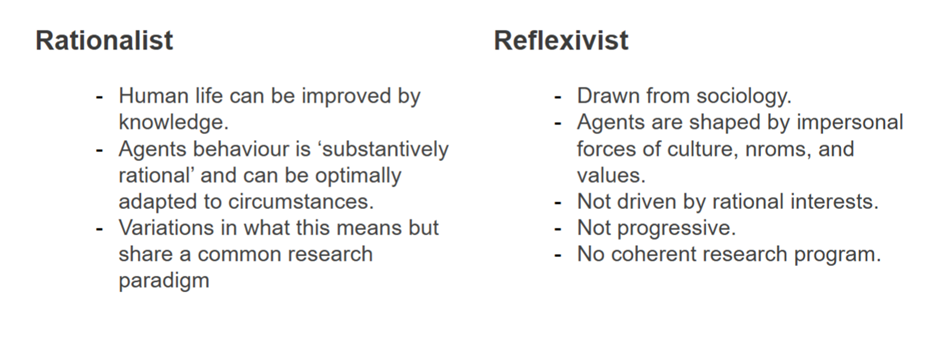
Links between Feminism and International Relations?
- Keohane is relevant to our topic because he writes International Relations
Theory: Contributions from a Feminist Standpoint in 1989.
- It brings rationalist condescension to feminism in IR.
- It is not meant to be dismissive, but the tenor of the article is very much this:
-Feminism is all well and good. It might even be able to help us neo- liberal institutionalists to develop our views, but it’s not terribly interesting on its own.
- Proposes ‘an alliance’ between neo-liberalism and feminism, where the latter can help make the former more robust.
- This is not overtly sexist, but the reaction is mixed.
Key ideas or arguments presented in J Ann Tickner’s You Just Don’t Understand?
- Identifies the problems that international relations has with feminism.
- Epistemological Differences:
-Discordant theories of knowledge: rationalism vs. feminist approaches.
•This includes standpoint theory, critical theory, ‘reflexivism’.
- Ontological Differences:
-Discordant theories of being: what the referent objects of international relations ought to be:
•States and international institutions v. Gender
- The simple fact of gender-based power.
This rationalism of people like Keohane is not objective. It has embedded in it what seems rational etc, but this is influenced by the patriarchy and masculinity.
Dynamism and gender inform international relations.
What is intersectionality in feminism?
Intersectionality - depending on class, race and gender, there is going to be a different experience of women. But there is always an intersection.
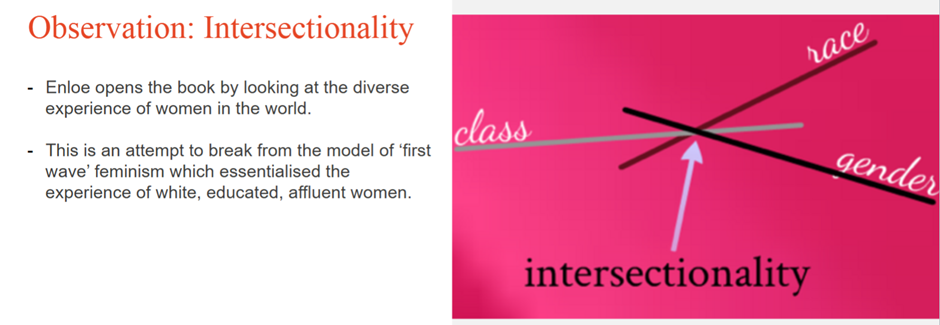
Where is the international and political in McEnloe’s book?`
- It is setting up the site of the international and the political to be in spaces normally judged to be:
- ‘private’
- ‘domestic’
- ‘local’
- ’trivial’
- Contrast this with conventional beliefs about international relations which focus on the structure of anarchy, the role of states, and high diplomacy.
Put simply, these invisible women are affected by the international system and they affect the international system
Difference between gender and sex?
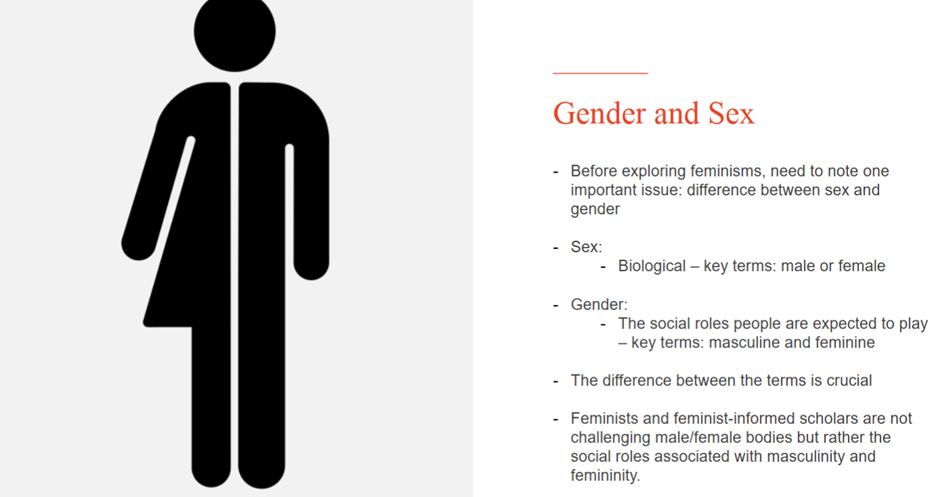
Masculinity and Femininity?
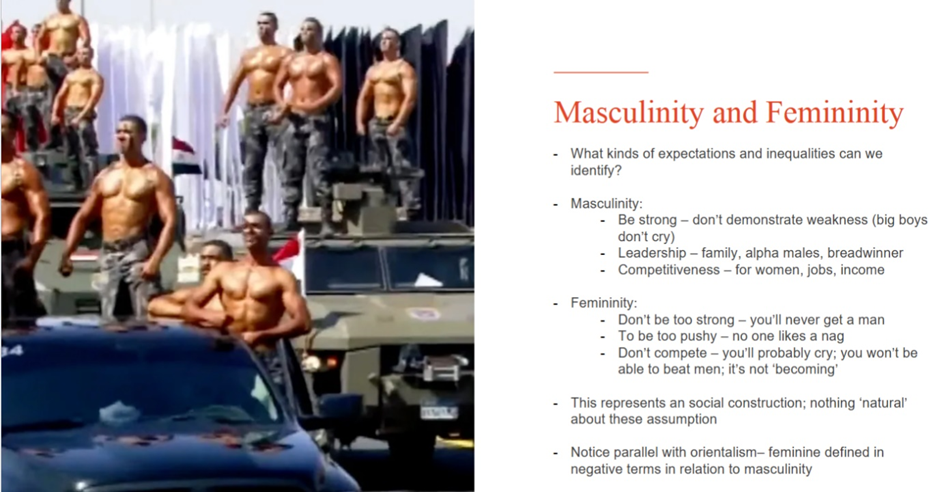
Power and the International System in accordance with Feminist Lenses?
- In common with many other theorists, she is interested in the sources of power
- The gendered roles aren’t accidental, but produced by power relations
- These powers operate inside and outside international relations – defence and security studies –
o “If one fails to pay attention to women – all sorts of women – one will miss who wields power and for what ends”.
What is an example of the personal intersecting with the political?
- Who recognises marriage? Which sort of marriage?
- Does marriage confer citizenship? Is it gendered?
- A man can confer citizenship on his wife, but a wife can’t on her husband.
- Does it confer citizenship by descent?
- What about instances of ‘same-sex marriage’?
- Polygamy and polyandery also raise challenges.
- Citizenship was patrolinear, children born out of wedlock did not have equal rights.
- Same sex couples moving to another country may not be able to reside there because their marriage is not recognised
What is McEnloe’s take on gendered power?
- Enloe, among many other feminists, argue that political power is far more diverse and invasive than many conventional theorists believe.
- This is a big claim since those who study politics and especially IR tend to be obsessive about power.
- But recall the Laswell claim that politics is about who gets what, when and how.
- - This applies to more than simple elections, laws, or international negotiations.
- Gendered roles play a significant role in assigning who gets what when and how.
- The failure of mainstream international relations experts to see this shows how effectively
reified gendered roles have become.
-Reification is the process by which something socially produced is thought to be natural.
- A good researcher, regardless of whether they wear the label of feminist, would do well to
internalise the simple question “How was this made?” and “Who benefits?”
“As one learns to look at the world through gender-curious feminist
eyes, one learns to ask whether anything that passes for natural,
inevitable, inherent, traditional, or biological has been made.”
What is transnational feminism and how do we take it seriously?
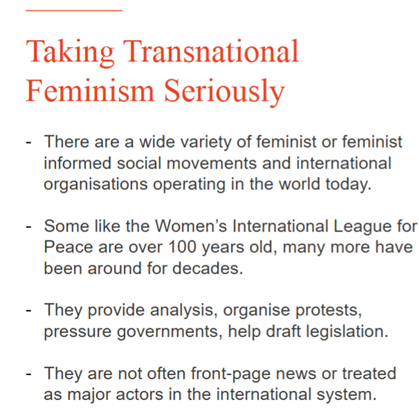
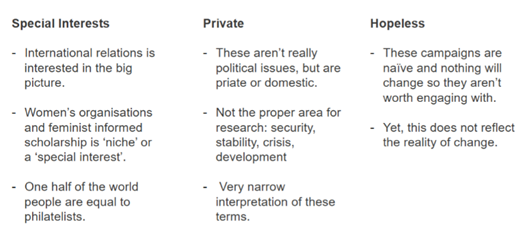
Case study of feminism and the transatlantic antislavery movement?
- The history of the abolitionist movement has focussed on the role of
prominent men such as Frederick Douglass, William Lloyd Garrison, and
William Wilberforce.
- However women were very prominent in the antislavery movement in Britain and North America. These women did the mass movement work, building campaigns to boycott sugar and mass petitioning.
- All done without voting rights, access to power, and the limits of 18th and 19th c. technology.
-It forces us to think about the way in which gendered and racialized power might have adapted or sustained slavery without women subverting power relations.
-The presence and influence of women forced anti-slavery campaigners to recognise forms of domination in otherwise ‘benign’ institutions like marriage. Reconsider relationships with women
-This provides the framework for subsequent campaigns, most notably women’s suffrage but also temperance. Note prohibition of alcohol (DV) and eugenics.
Case Study: The Arms Trade Treaty?
- Feminist campaigners and researchers did research and lobbying to shape the Arms
Trade Treaty.
- This required companies involved in the arms trade to do risk assessments as to whether their products were likely to be used to violate human rights.
- This included a clause to assess ‘serious acts of gender-based violence’
- This was done by continuous lobbying of UN delegations especially from the Women’s
International League for Peace and Freedom, International action Network on Small
Arms, and Global Actin to Prevent War and Armed Conflict.
- They were also engaged in research but quantitative and qualitative to show that political violence is also gendered violence.
- Their big opponent was The Vatican, which has observer status at the UN, which wanted no binding clauses and to use the language of “violence against women and children”
-Recall Enloe writing about ’womenandchildren’ in the context of refugees. They believed this phrase to be victimising women.
- The point that Enloe drives at is that this is impactful research and lobbying in modern
international politics that cannot be ignored.
McEnoe’s Argument about Gender making the world go around?
- Enloe argument in this chapter is direct.
- She is defending feminist informed research and campaigning.
- She sets the stage for the book’s examination of the ways in which the international effects women (and indeed men).
- She argues that gendered power relations are complex and relevant.
- The consequences of not studying these is to leave dimensions of politics that shape the life chances of all human beings unexplored.
- Gender makes the world go round means that gendered power relations are
built into the architecture of the global economy, international organisations,
military power.
- It shouldn’t be dismissed as irrelevant or ancillary to other projects.
- You must recognise that feminist IR is real. It is not niche and is central to the international.
Tourism as a source of gendered power?
- Tourism does not seem to be the site of power, but Enloe argues that there are international power relations at play in ideas of travel and tourism.
- The first point to be made is the use of travel as the means of women asserting autonomy; unescorted women travelling in the world was until very recently something mildly scandalous.
- “Good girls go to heaven, bad girls go everywhere”
- However, the story of travel and tourism is interlinked with hierarchies of gender and race.
- The white woman travellers in the 19th century formed part of imperial discourse bringing back tales of the exotic East and justifying European domination, though they were busting out of gendered norms.
- Other modes of seeing the world develop as a means to civilise travel for women such as the sanitised bringing of the world to women via World’s Fairs and Exhibition.
- Decent women do not need to go to the world, they can have the world brought to them.
How do you resolve an interest in the world with respectability?
How is tourism inherently political?
- However, the modern tourism industry develops as a way to make travel ‘safe’
- Packages tours reduced chances of exposure to unladylike circumstances.
- The tourism industry becomes a major global industry which serves as a plank for development, breaking reliance on the export of natural resources as a source of foreign currency.
- Women travellers become an important source of development funding as consumers in this industry.
- This can give strong incentives to reduce some forms of gendered power. If women do not feel safe travelling in certain countries, these countries stand to loose significant amounts of money.
-This happened in Egypt after the Arab Spring when there was widespread reporting of harassment of feminist activists and protests against the Mubarak and post-Mubarak government.
- Enloe is careful not to focus exclusively on the white woman traveller.
- The development of the tourism industry has produced a large amount of feminised labour.
- She focused on the chambermaid as the key example.
- There is a contrast between the masculinised plantation labour swinging a machete and working in agriculture and the chambermaid who is subservient and invisible.
- The work force in tourism is overwhelmingly feminised: The International Labour Organisation estimates 55.5% of tourism workers globally are women with the proportion being as high as 75% in particular regions.
- Women also occupy the lowest paid most precarious positions in this industry.
- They are compelled to act in certain ways that emphasises subservience and deference.
- They generate a great deal of value but receive little by way of compensation.
- However, remember that even oppressed people have agency and there have been movements for labour organisation led by women in these industries looking for a bigger share.
- Thailand – specific image of femininity is given.
o Tourism can also be used as a vehicle of oppression on women, enforcing low pay.
How does the tourism industry continue to enact gendered politics and power onto women?
- - The last thing to mention is the sex tourism and sex trafficking.
- This is a major industry with estimates that child sex trafficking alone is worth some $20
billion dollars according to the UN’s Human Rights Council Special Rapporteur Najat Maalla
M’jid.
- Sex tourism and trafficking are distinct but interrelated social phenomenon.
- The first encourages people, largely men, to travel to particular destinations to gain access to the sexual services of women and girls (to a lesser extent men and boys). There is a least a conceptual possibility here that sex workers are working out of choice.
- The second deals with the women who have been coerced into work in sex industries; often
referred to as sex slavery because the women and girls have had their basic autonomy
severely violated by the organisations who keep them in involuntary service and the men who
use their services.
- This is a transnational phenomena that involves moving women and girls across borders for
profit not unlike the global narco trade.
Can have a fundamentally damaging effect on one’s ability to live a healthy lifestyle.
- - Women get caught in these via political choices:
-Economic crisis: in times of economic crisis government often engage in austerity,
cutting social services and reducing spending; this can make women in financially
perilous positions vulnerable to trafficking.
-This is driven by international politics and political economy: the International Monetary
Fund’s pursuit of structural adjustments.
-The effects of financial deregulation in the USA producing a global financial crisis.
-Natural disasters: these disrupt communities and produce vulnerability.
-How is this political? Constraint the difference between the earthquakes in Haiti in 2008
and in New Zealand in 2011; roughly comparable but a wealthier state is better able to
cope with disaster through building stronger infrastructure and having better organised
emergency relief etc.
-Political and Militarised Violence: women fleeing violence are left vulnerable; refugee
camps have become sites of sexual violence and exploitation, sometimes between aid
workers and refugees.
The role of crisis in entrenching gender based inequality and gender politics?
- Economic crisis funds sex trafficking. Governments unable to fund debts – the social projects cut are usually affecting women and children, making them vulnerable to sex trafficking
- Natural disasters are also significant. IE Earthquake in Haiti vs NZ, NZ -> effective infrastructure, good government, but Haiti does not. Women of Haiti became vulnerable to sex trafficking
- Most men there for aid etc, will be the main proponents. Civil war, guerilla campaigns -> including coercion in refugee camps. They had no choice, they could not report them; their children’s education was controlled, these are the people that have access to water.
Why are base women interesting sites of international politics?
they are enclaves of distinct authority; they are quasi-sovereign or sometimes explicitly sovereign but rooted in local communities. They cannot be maintained without support.
- They often have different structural authority: militarised versus democratic and are highly patriarchal, masculine, and racialised spaces.
- American military bases in the UK during the Second World War, for example, caused concerns about imperial status and race.
-White British women being romantically entangled and marrying Black American servicemen seemed to invert the power dynamics underpinning British superiority.
-Similar story about ‘War Brides’ in Australia when American service
personnel arrived in WWII
Base Women
- Overseas military bases often are sites of protest as they are deeply unpopular with local communities.
- Enloe gives the example of Subic Naval and Clark Airforce Base in Luzon, Philippines.
- These bases were part of the USA’s Pacific security cordon in the Cold
War.
- These bases were seen as causing large social problems especially with prostitution and violence against women.
-1 in 3 children born to Philippine women and American servicemen became street children; many working in the sex industry.
-This became a vector for the HIV/AIDS in the 1980s.
- Campaigners led by women managed to lobby the Philippine government to get the bases closed after the Cold War. Protested with catholic church
-Though in connection to the nationalist discourses in the previous chapter there is a connection between protecting the ‘honour’ of women and feminist-informed, women-led protest groups